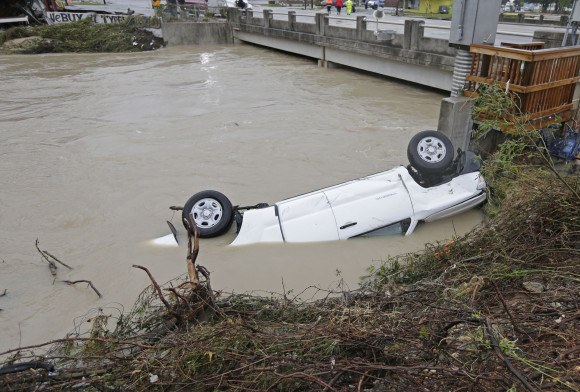Claims are already starting to trickle in from the major storm that hit South Carolina over the weekend and is now causing additional flooding problems in North Carolina.
According to State Farm Spokesman Justin Tomczak, the insurer had received approximately 520 homeowners claims in North Carolina and approximately 1,740 homeowners claims in South Carolina as of Tuesday morning.
State Farm auto claims in North Carolina totaled approximately 100 so far. South Carolina saw significantly more – about 1,130 claims by Tuesday morning; two-thirds of those were non-drivable – meaning the insured cannot drive their car to a claims site to have it looked at.

“Claims are concentrated in the Columbia and Charleston [South Carolina] areas, but we are receiving claims from all around the state. Claims are continuing to rise as people survey the damage. Approximately two-thirds of the auto claims are from cars that are non-drivable. State Farm catastrophe claim representatives are in the area assisting our customers and have been since the weekend,” said Tomczak.
State Farm is the largest writer of home and auto policies in South Carolina.
Flood insurance claims should also be high once filing gets underway. However, with flood damage being excluded under standard homeowners, renters and business insurance policies, flood victims will need to have coverage under a separate policy from the National Flood Insurance Program (NFIP) or from a private flood insurer to be eligible for reimbursement from flood damage.
The optional comprehensive portion of an auto insurance policy provides coverage for flood-related damages.
The NFIP provides coverage for up to $250,000 for the structure of the home and $100,000 for personal possessions. For businesses the coverage is $500,000 for a commercial structure and $500,000 for its contents.
The Insurance Information Institute (I.I.I.) reported that as of July 31, South Carolina had 199,540 NFIP policies in force with written premiums totaling $133.4 million covering $50.8 billion in property and contents.
In North Carolina, there were 132,498 policies in force as of July 31 with written premiums totaling $105 million covering $32 million in property and contents.
South Carolina is no stranger to flooding problems. The state actually ranks sixth in the nation for number of NFIP policies, behind more populated states like Florida, Texas, California, and ahead of New York, according to data from the NFIP.
Catastrophe modeling firm AIR Worldwide says South Carolina’s combined impact of atmospheric conditions and a lack of proper maintenance of flood control and drainage systems has contributed to the states issues.
Flood control mitigation efforts have been in place for many years, but South Carolina has a significant number of vulnerable structures despite these efforts. Approximately 85 percent of the residential construction is wood, with an estimated 20 percent having basements. The presence of a basement increases the risk for contents and building damage, AIR Worldwide said in a statement. More than half of the commercial buildings are steel and concrete. Unlike residential structures, these buildings often have engineering attention and are built to stricter standards, but are nevertheless susceptible to high water flow velocities.
A 2013 analysis from AIR Worldwide estimated insured value of properties in coastal areas of South Carolina totaled $239.3 billion in 2013, accounting for 28 percent of the state’s total insured property exposure.
Experts in the insurance industry say it is too early to know what the cost will be of this mega storm, which was brought to land by tropical moisture from Hurricane Joaquin. The mega-storm conditions hit many areas of the Southeast coast beginning Thursday, with South Carolina bearing the brunt of it over the weekend. Rain continued in North Carolina Tuesday.
South Carolina Insurance Director Raymond Farmer said the storm will be considered primarily a flood event and he expects a “great influx of claims” particularly on the auto side. The Associated Press reported the South Carolina Highway Patrol responded to more than 300 collisions around the state by 6 a.m. Sunday and many other vehicles were abandoned in flood waters.
“There are untold numbers of automobiles caught up in floods,” Farmer said.
Russ Dubisky, executive director for the South Carolina Insurance News Service, said it is still early in the process but he expects to see significant losses to both insured and uninsured property.
“The feedback from our member companies so far is the bulk of insured losses will be auto,” said Dubisky.




















 How Insurers Can Avoid Post-Merger Technology Failure
How Insurers Can Avoid Post-Merger Technology Failure  Surge of Supercharged Hurricanes Prompt Call for Cat 6 Classification
Surge of Supercharged Hurricanes Prompt Call for Cat 6 Classification  Nearly Half of 100 Largest P/C Insurers Destroy Value: ACORD
Nearly Half of 100 Largest P/C Insurers Destroy Value: ACORD  Why the Middle Market Matters and How Insurers Can Capture It
Why the Middle Market Matters and How Insurers Can Capture It 




